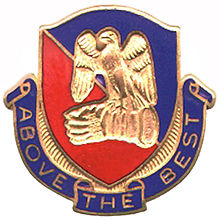- United States Army Aviation School
-
The United States Army Aviation School is located at Fort Rucker, Alabama
Contents
History
In 1912 the facility was located in College Park, Maryland.[1]
- Organic Army Aviation first entered into combat in November 1942 on the coast of North Africa. During World War II, L-4 Grasshoppers and a few larger L-5 Sentinels were used to adjust artillery fire, gather intelligence, support naval bombardment, direct bombing missions, and perform other functions. Most training of both pilots and mechanics was conducted by the Department of Air Training within the Field Artillery School at Henry Post Army Airfield, Okla., although the Army Air Forces conducted some primary training of organic Army Aviation personnel. The Korean War provided new challenges and opportunities for Army Aviation. Organic Army Aviation had acquired its first helicopters, thirteen H-13 Sioux, in 1947, shortly before the U.S. Air Force became independent of the Army. In Korea, the Army employed the O-1 Bird Dog and other improved fixed wing planes, but also helicopters. The Army used its H-13s primarily for medical evacuation, command and control, and transport of lightweight and valuable cargo. Because of the rugged terrain of the Korean peninsula, the value of helicopters came to be recognized by all the services; the demand for both helicopters and trained aviators consistently exceeded the supply. In 1951 the Army began organizing five helicopter transport companies and training warrant officer pilots. There was, however, an ongoing rivalry between the Army and the Air Force concerning responsibility and resources for the aerial support of ground forces. Because of this rivalry, and also because of the shortage of helicopters, only two Army transport companies were supplied with H-19 Chickasaw helicopters in time to participate in the Korean War. Transport helicopters nevertheless proved themselves by moving cargo and personnel during the final months of the war and then by participating in prisoner exchanges and other functions after the cessation of hostilities. During the Korean War, the Department of Air Training at Post Field expanded, and in early 1953, it became the Army Aviation School. As a result of the expansion of both aviation and artillery training, Post Field became overcrowded, and the Army decided to move the Army Aviation School to a different post. When no satisfactory permanent Army post was found, a temporary post, Camp Rucker, Ala., was chosen.
The Army Aviation School began moving to Alabama in August 1954 and the first class began at Rucker in October.
Training
It is where officers not only learn to fly their specific Army aircraft, but also to employ aviation assets to assist United States forces. Students usually spend 15–18 months in aviation school, learning a wide range of subjects, and finally graduating with their "wings" or Aviator's Badge. When second lieutenants arrive at Fort Rucker after graduating from their commissioning source (USMA, ROTC or OCS) they secure housing, they attend the two month Basic Officer Leadership Course (BOLC B) at Fort Rucker. Upon completion, they join the rest of their classmates, usually junior Warrant Officers, many of whom have previous enlisted experience. Before starting academics, students must complete Dunker training and Army SERE (Survival, Evasion, Resistance and Escape) school. They move on to Junior Officer Professional Development, a short course covering Army basics, from soldier support to instruction on military law. This course is followed by BOLC B, the first half of what was previous called Aviation Branch Officer Basic Course. Classes during this three week course are more specific to the aviation branch, including the aircraft maintenance process, general aviation doctrine, and US and foreign vehicle and aircraft identification. After BOLC B, students transition to Initial Entry Rotary Wing Aeromedical Training, or "aeromed" at the US Army School of Aviation Medicine. Here, they learn how flight affects physiology, toxicology, gravitational forces and other subjects pertaining to flight and the human body. The information taught in these classes remains testable information throughout flight school, and is asked frequently by instructor pilots (IPs).
See also
- Coats of arms of U.S. Army Aviation Regiments
- United States Army Aviation Center of Excellence
- Milton Crenchaw
Notes
- ^ "Lieut. Hazelhurst and Al Welsh, Professional Aviator, Victims of Airship Test.". New York Times. 12 June 1912. http://query.nytimes.com/gst/abstract.html?res=9505E1D7153CE633A25751C1A9609C946396D6CF. Retrieved 4 September 2009. "Lieut. Leighton W. Hazelhurst, Jr., of the Seventeenth Infantry, one of the most promising of the younger aviators of the army, and Al Welsh, one of the most daring professional aviators in America, were instantly killed in a flight at the Army Aviation School at College Park, Md., at 6:30 o'clock this evening."
Sub-commands - Accessions Command
- Center for Army Lessons Learned
- Combined Arms Center
- Combined Arms Support Command / Sustainment Center of Excellence
- TRADOC Analysis Center

Installations Schools - Air Assault School
- Air Defense Artillery School
- Airborne School
- Armor School
- Aviation School
- Basic Training
- CBRN School
- Sniper School
- Combatives School
- Command and General Staff College
- Defense Language Institute
- Engineer School
- Field Artillery School
- Infantry School
- Intelligence Center
- Jumpmaster School
- Army Logistics University
- Mountain Warfare School
- Officer Candidate School
- Pathfinder School
- Prime Power School
- Quartermaster School
- Ranger School
- School of Advanced Military Studies
- Sergeants Major Academy
- Special Forces Qualification Course
- Soldier Support Institute
- War College
- Warrant Officer Candidate School
- United States Military Academy (West Point)
Categories:- United States Army stubs
- Aviation schools
- United States Army schools
- Aviation units and formations of the United States Army
Wikimedia Foundation. 2010.

